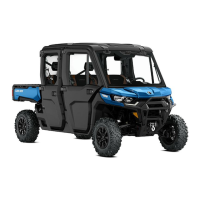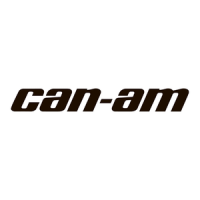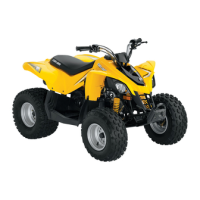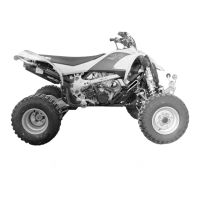PREPARE TO RIDE
Be fore you Ride
Perform pre-ride inspection to confirm
the safe operating condition of your
vehicle. Refer to
PRE-RIDE INSPEC-
TION
.
Driver and pass engers must:
– B e properly s ea ted.
– Latch side nets and fasten seat
belts.
– Wear appropriate riding gear. (Refer
to
RIDING GEAR
.)
Riding Gear
It is important that the operator and
passengers al way s wea rs appropriate
protective clothing and ap pa rel, includ-
ing:
– Anapprovedhelmet
– Eye prote ction
– B oots
–Gloves
– A long sl eev ed sh irt or jacket
– Long pa nts.
Depending on conditions, anti-fogging
goggles may be required.
1
2
3
4
5
6
rmo2008-001-019_a
RIDI NG GEAR
1. Approved helmet
2. Eye and face protection
3. Long sleeves shirt or jac ket
4. Gloves
5. Long pants
6. Boots (over-the-ankle footwear)
Weather conditions shoul d help you
decide how to dress. To max imiz e
comfort and a v oid frostb ites in w in-
ter, dress f or the coldes t weather ex-
pected. Therma l underwe ar next to
the skin also provides good insulation.
Never wear any loose clothing that
may get entangled in the vehicle or on
tree branches and shrubs.
Helmets and Eye Protection
Helmets protect the head and brain
from injury. Even with the v ehicle's
cage and s ide nets, objects can en-
ter the cockpit and strike the head, or
the head can strike the cage itself or
objects o utside t he vehicle. Even the
best helmet is no gua ran tee against
injury, but statistics indicate that hel-
met use significantly re duces the risk
of brain injury. So, be safe and al way s
wear a helmet while ridi ng.
Choosing a Helmet
Helmets should be manufactured to
meet the a ppropriate s ta nda rd in y our
state, province or country and shoul d
fit properly.
A hel m et with fa c e protection is a bet-
ter choice as it protects also against
frontal impacts. It can also protect
against debris, s tones , insects , the el-
ements, etc .
An open-face helmet does not offer the
same protection for the face and chin.
If y ou wear an open-face helmet, you
should use a snap-on face shield and/or
a pair of goggles. O rdinary gl a sses or
sunglasses are not sufficient eye pro-
tection for riders. They can s hatter
or fly off, and they allow wind a nd air-
borne objects to reac h the eye s.
For w inter ridin g conditions, a stock-
ing typ e cap, balaclava and face mask
should alway s be carried or worn.
________
SAFETY INFOR MAT ION
________
17

